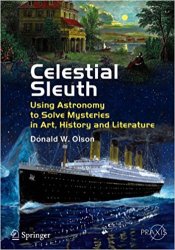Celestial Sleuth: Using Astronomy to Solve Mysteries in Art, History and Literature
- Добавил: harun54
- Дата: 6-05-2019, 18:38
- Комментариев: 0
 Название: Celestial Sleuth: Using Astronomy to Solve Mysteries in Art, History and Literature
Название: Celestial Sleuth: Using Astronomy to Solve Mysteries in Art, History and LiteratureАвтор: Donald W. Olson
Издательство: Springer
Год: 2013
Формат: PDF
Размер: 20 Мб
Язык: английский / English
For a general audience interested in solving mysteries in art, history, and literature using the methods of science, 'forensic astronomy' is a thrilling new field of exploration. Astronomical calculations are the basis of the studies, which have the advantage of bringing to readers both evocative images and a better understanding of the skies.
Weather facts, volcano studies, topography, tides, historical letters and diaries, famous paintings, military records, and the friendly assistance of experts in related fields add variety, depth, and interest to the work. The chosen topics are selected for their wide public recognition and intrigue, involving artists such as Vincent van Gogh, Claude Monet, Edvard Munch, and Ansel Adams; historical events such as the Battle of Marathon, the death of Julius Caesar, the American Revolution, and World War II; and literary authors such as Chaucer, Shakespeare, Joyce, and Mary Shelley. This book sets out to answer these mysteries indicated with the means and expertise of astronomy, opening the door to a richer experience of human culture and its relationship with nature.
Each subject is carefully analyzed. As an example using the study of sky paintings by Vincent van Gogh, the analytical method would include:
- computer calculations of historical skies above France in the 19th century
- finding and quoting the clues found in translations of original letters by Van Gogh
- making site visits to France to determine the precise locations when Van Gogh set up his easel and what celestial objects are depicted.
For each historical event influenced by astronomy, there would be a different kind of mystery to be solved. As an example:
- How can the phase of the Moon and time of moonrise help to explain a turning point of the American Civil War - the fatal wounding of Stonewall Jackson at Chancellorsville in 1863?
For each literary reference to astronomy, it was determined which celestial objects were being described and making an argument that the author is describing an actual event. For example, what was the date of the moonlit scene when Mary Shelley first had the idea for her novel “Frankenstein?”
These and more fun riddles will enchant and delight the fan of art and astronomy.
Внимание
Уважаемый посетитель, Вы зашли на сайт как незарегистрированный пользователь.
Мы рекомендуем Вам зарегистрироваться либо войти на сайт под своим именем.
Уважаемый посетитель, Вы зашли на сайт как незарегистрированный пользователь.
Мы рекомендуем Вам зарегистрироваться либо войти на сайт под своим именем.
Информация
Посетители, находящиеся в группе Гости, не могут оставлять комментарии к данной публикации.
Посетители, находящиеся в группе Гости, не могут оставлять комментарии к данной публикации.
